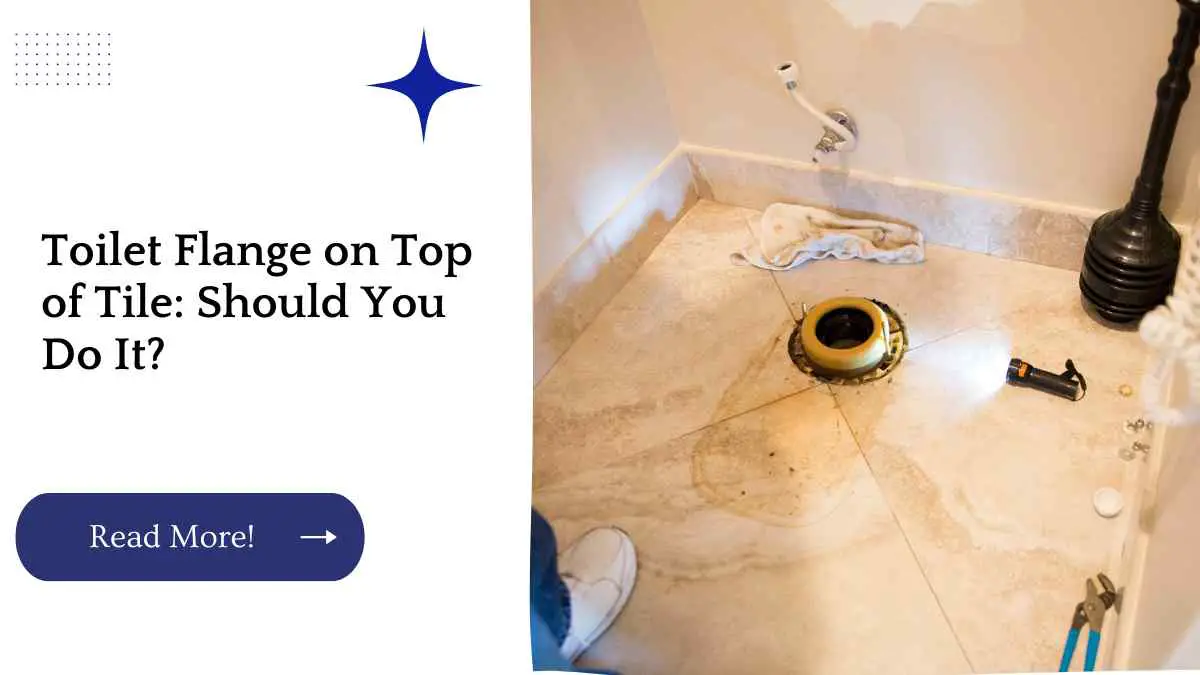The toilet flange is a critical component of your toilet installation. It connects your toilet to the waste pipe and helps create a secure and watertight seal. But when it comes to installing the flange, you have a few options. One of the biggest decisions you’ll need to make is whether to install the flange on top of the tile or below it.
In this article, we’ll explore the pros and cons of each installation method and provide some guidance on how to choose the best option for your bathroom.
| Takeaways |
|---|
| Choosing whether to install a toilet flange on top of or below the tile can impact the height of your toilet and the stability of the connection. |
| Installing a flange below the tile can be more secure but may require more work to install, while installing a flange on top of the tile can be easier and less invasive. |
| Consider factors like floor height, subfloor material, toilet type, and bathroom style when choosing your installation method. |
| Follow the manufacturer’s instructions carefully when installing a toilet flange, and test your toilet thoroughly to ensure that it is stable and watertight. |
| If you’re not confident in your DIY skills, it’s best to hire a professional plumber to handle the installation. |
What is a Toilet Flange?
Before we dive into the installation methods, let’s first define what a toilet flange is. A toilet flange is a round, metal or plastic ring that sits on top of your waste pipe. It has a flat surface that connects to your toilet’s base and a raised lip that sits on top of your bathroom floor.
Why is the Toilet Flange Important?
The toilet flange serves several critical functions. First, it connects your toilet to the waste pipe and helps create a watertight seal. It also helps support the weight of your toilet and keep it in place. Without a secure flange, your toilet could wobble or even come loose, causing leaks and damage to your bathroom floor.
Is your toilet flange rusted? Don’t worry, we’ve got you covered. Check out our guide on how to replace a rusty toilet flange for a step-by-step solution to your problem.
Installing a Toilet Flange Below the Tile
Pros
Installing a toilet flange below the tile has a few benefits. For one, it provides a more secure connection between the flange and the waste pipe. This is because the flange is anchored directly to the subfloor, which provides a stable base for your toilet.
Another benefit is that installing the flange below the tile can help ensure that your toilet is level. This is because the flange can be adjusted to the correct height before the tile is installed, which can help prevent any wobbling or rocking of the toilet once it’s installed.
Cons
However, there are also a few drawbacks to installing the toilet flange below the tile. For one, it can be more difficult and time-consuming to install. This is because you’ll need to remove some of the subfloor around the waste pipe to create a recessed area for the flange to sit in. This can add time and expense to your renovation project.
Additionally, installing the flange below the tile can limit your options when it comes to toilet type. Some toilet models may not work with a flange that is installed below the tile. This is because the height of the flange can affect the height of the toilet, which can in turn impact the comfort and usability of the toilet.
A level toilet is essential for preventing leaks and ensuring proper function. Learn more about the importance of a level toilet and how to achieve it with our guide on maintaining a level toilet.
Installing a Toilet Flange on Top of the Tile
Pros
Installing a toilet flange on top of the tile has its own set of advantages. For one, it can be easier and less invasive to install than a flange that is installed below the tile. This is because you won’t need to remove any subflooring, which can save time and money.
Another benefit is that installing the flange on top of the tile can give you more flexibility when it comes to toilet options. You’ll have more leeway to choose a toilet model that fits your needs and preferences, as the height of the flange won’t be a limiting factor.
Cons
However, there are also some drawbacks to installing the toilet flange on top of the tile. For one, it may not be as secure as a flange that is installed below the tile. This is because the flange will be anchored to the tile rather than the subfloor, which can create a less stable base for your toilet.
Another potential issue is that installing the flange on top of the tile can raise the height of your toilet. This can make it less comfortable and less usable, especially for people with mobility issues or disabilities.
Eliminate grease buildup and keep your kitchen drain flowing smoothly with these easy-to-follow tips. Check out our guide on cleaning your kitchen drain for helpful hints and simple solutions
Factors to Consider When Choosing Your Installation Method
When it comes to choosing between installing your toilet flange on top of the tile or below it, there are a few key factors you should consider. These include:
Floor Height
The height of your bathroom floor can affect your installation options. If your floor is already high, you may want to install the flange on top of the tile to avoid making your toilet too tall. However, if your floor is low, you may want to install the flange below the tile to ensure a secure and stable connection.
Subfloor Material
The type of subfloor you have can also impact your installation options. If you have a concrete subfloor, it may be more difficult to install the flange below the tile. On the other hand, if you have a wooden subfloor, installing the flange below the tile may be easier.
Toilet Type
The type of toilet you plan to install can also affect your installation method. Some toilet models may require a flange that is installed below the tile, while others may work better with a flange that is installed on top of the tile.
Bathroom Style
Finally, consider your overall bathroom style when choosing your installation method. If you have a modern or contemporary bathroom, you may prefer the sleek look of a flange that is installed on top of the tile. On the other hand, if you have a more traditional or classic bathroom, you may prefer the secure and stable connection of a flange that is installed below the tile.
Choosing the right drainage pipe for your driveway can be tricky. Our guide on finding the right drainage pipe provides useful tips and advice for selecting the perfect pipe for your drainage needs.
How to Install a Toilet Flange
Regardless of which installation method you choose, installing a toilet flange is a relatively straightforward process. Here are the basic steps:
- Remove the old flange if necessary.
- Measure the height of the new flange to ensure that it will fit properly.
- Install the new flange according to the manufacturer’s instructions.
- Attach the toilet to the flange using the provided hardware.
- Test the toilet to ensure that it is stable and watertight.
Further Reading
Here are some additional resources on toilet flange installation:
Five Best Practices When Installing Toilet Flange – This blog post offers some helpful tips for ensuring a successful toilet flange installation, including how to choose the right flange and how to properly secure it to the subfloor.
Should My Toilet Flange Sit on Top of the Backer Board or the Tile of the Floor? – This forum post offers some useful insights from DIYers and professionals on the pros and cons of installing a toilet flange on top of the tile or below it.
Toilet Flange on Top of Tile: What You Need to Know – This article provides a comprehensive guide to installing a toilet flange on top of tile, including step-by-step instructions and tips for choosing the right flange for your bathroom.
Conclusion
When it comes to installing your toilet flange, there are pros and cons to both methods. Ultimately, the best option for you will depend on a variety of factors such as your floor height, subfloor material, toilet type, and bathroom style.
If you’re looking for a more secure and stable connection, installing your flange below the tile may be the better choice. However, if you want an easier and less invasive installation process, installing your flange on top of the tile may be the way to go.
Whichever method you choose, be sure to follow the manufacturer’s instructions carefully and test your toilet thoroughly to ensure that it is stable and watertight. With the right installation method and a little bit of care, you can enjoy a comfortable and functional toilet for years to come.
Preventing basement leaks is essential for maintaining the integrity of your home’s foundation. Check out our guide on tips for sewer pipe maintenance for helpful hints and solutions to prevent water damage and costly repairs.
FAQs
Can I install a toilet flange on top of the tile without removing the old flange?
It’s generally not recommended to install a new flange on top of an old flange, as this can create an unstable and potentially dangerous connection. It’s best to remove the old flange before installing a new one.
Will installing the flange below the tile make my toilet more secure?
Yes, installing the flange below the tile can provide a more secure and stable connection between the flange and the waste pipe.
Can I install a toilet flange on top of a tile that is already installed?
Yes, you can install a toilet flange on top of a tile that is already installed. However, be aware that this may not be as secure as installing the flange below the tile.
Can I use any toilet model with a flange that is installed on top of the tile?
Most toilet models can work with a flange that is installed on top of the tile. However, be sure to check the manufacturer’s specifications to ensure compatibility.
Do I need to hire a professional to install my toilet flange?
While it’s possible to install a toilet flange yourself, it can be a tricky and time-consuming process. If you’re not confident in your DIY skills, it’s best to hire a professional plumber to handle the installation.

Hellen James is the author of the blog and a licensed plumber with over 15 years of experience. She shares her knowledge and experience in plumbing and drainage through insightful and informative articles

